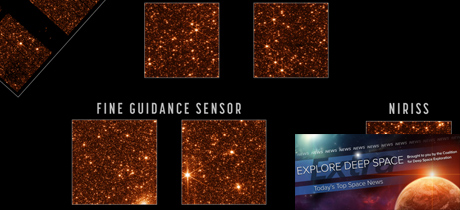In Today’s Deep Space Extra… UAE signs deal with Axiom Space to secure an extended mission to the International Space Station. Russian space walkers have helped place Europe’s International Space Station robotic arm in motion for the first time. With its multi-segment mirror now aligned, the James Webb Space Telescope is entering the instrument calibration phase of the observatory’s commissioning.
Human Space Exploration
Emirati astronaut set for six-month mission to International Space Station
Coalition Members in the News – Axiom Space, Boeing, United Launch Alliance
Thenationalnews.com (4/29): The UAE has purchased a seat on the Crew-6 mission from private company Axiom Space. The deal, signed on Wednesday at the UAE Embassy in Washington, will allow an Emirati astronaut to spend six months aboard the International Space Station (ISS). This will be the UAE’s second mission to space, following Hazza Al Mansouri’s historic eight-day trip to the ISS in 2019.
European robotic arm moves for first time during 250th spacewalk at Space Station
Space.com (4/28): Cosmonauts Oleg Artemyev and Denis Matveev set the European Space Agency’s (ESA) robotic arm contribution to the International Space Station’s Russian segment into motion on Thursday during a more than seven-hour spacewalk. The lengthy excursion transitioned the launch configuration of the 37-foot-long robotic arm into a more operational status. More spacewalks in the coming months will be required to establish a capability for the robotic arm to move payloads and spacewalking cosmonauts around the exterior of the orbital lab’s Russian segment. The robotic arm is part of the Russian Nauka Multipurpose Laboratory Module, which was launched to the ISS in July 2021.
Space Science
James Webb telescope completes optical alignment, ready for final instrument calibration phase of commissioning
Coalition Member in the News – Northrop Grumman
NASAspaceflight.com (4/28): With the multi segments of the James Webb Space Telescope (JWST) now aligned, the space observatory has entered a new phase of commissioning, NASA announced. That next phase is a calibration of each instrument to prepare for the start of scientific observations. “Every step of the way, things have been going either exactly as planned or better than planned, which has just been an incredibly great feeling,” said Charlie Atkinson, Chief Engineer for Northrop Grumman’s JWST Program. “We’re getting an indication that the actual optical performance of the telescope is actually better than we expected.” The JWST was launched on December 25, 2021 to begin a lengthy commissioning phase.
NASA and DLR to end SOFIA operations
SpaceNews.com (4/28): A long running relationship between NASA and the German space agency, DLR, for airborne celestial observations with the SOFIA observatory is scheduled to come to an end in September. SOFIA is an infrared observatory mounted aboard a Boeing 747 aircraft. High operating costs are to blame, and the National Academies of Sciences has recommended termination so that $85 million in operational costs can be re-invested in other mission priorities.
Other News
Northrop Grumman expects a $2 billion order from ULA for solid rocket boosters
Coalitions Members in the News – Aerojet Rocketdyne, Northrop Grumman, United Launch Alliance
SpaceNews.com (4/28): Northrop Grumman is anticipating a $2 billion contract from United Launch Alliance (ULA) for the production and delivery of solid rocket boosters to support dozens of mission launches annually by ULA’s new Vulcan Centaur rocket. Vulcan Centaur is expected to make its premiere launch later this year. ULA will offer Vulcan in four standard configurations including zero, two, four, and six solid rocket booster variants.
China launches pair of commercial remote sensing satellites, sea launch scrubbed
SpaceNews.com (4/29): A Chinese Long March 2C rocket placed two commercial optical remote sensing satellites into highly inclined orbits early Friday.
Rocket Lab to attempt mid-air helicopter catch of Electron rocket after launch
UPI.com (4/29): Rocket Lab will attempt to recover the first stage of an Electron rocket for reuse by catching it with a helicopter after burnout. The launch is planned for Friday evening at 6:35 p.m. EDT, from New Zealand. The helicopter is a Sikorsky S-92. Electron’s payload is 34 small satellites.

